
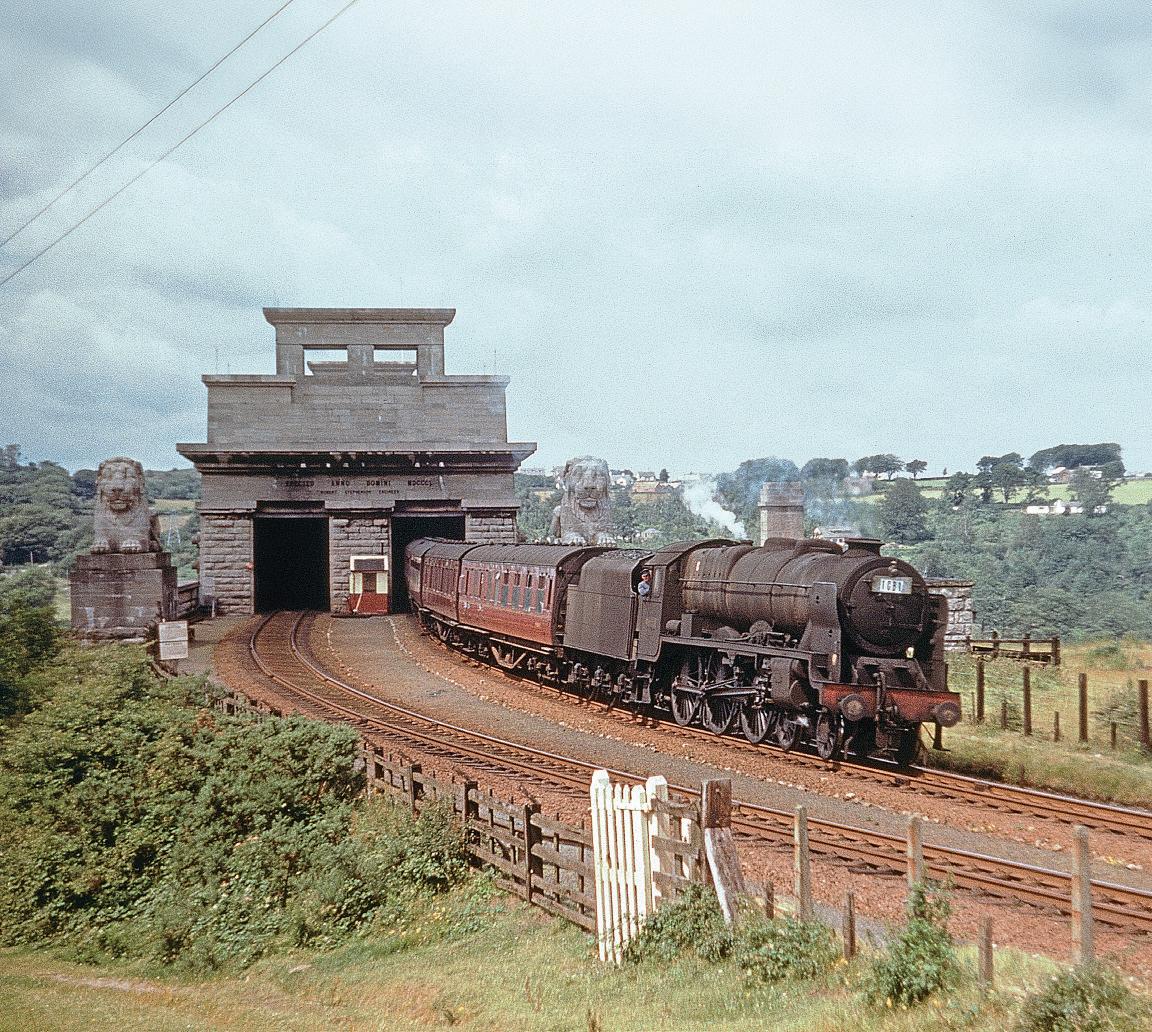
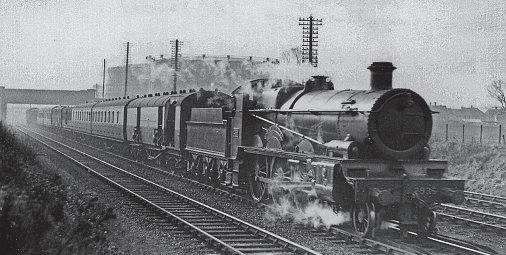
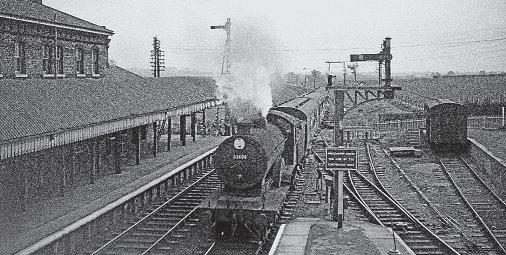

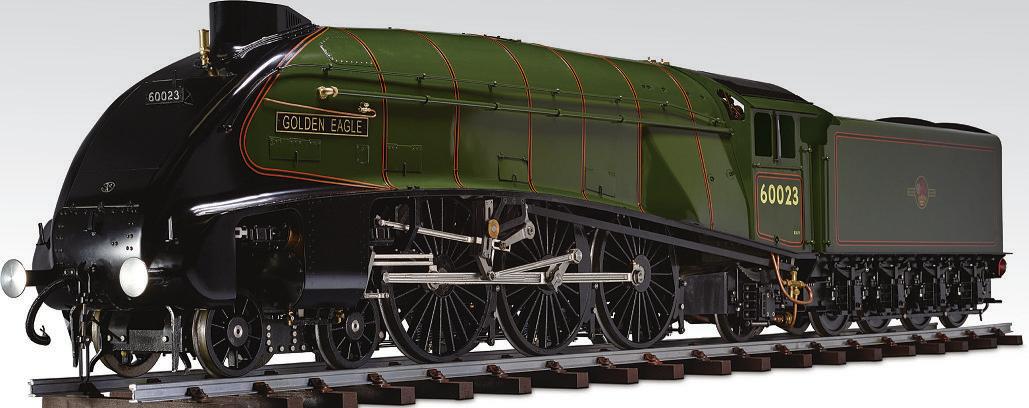













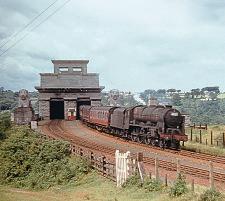


Cove r: Em er gingf ro mt he Br it an ni aB ri dge up on cr os si ng th eM en ai St ra it fr om th eI sl e of Angl es ey,r eb ui lt Roya lS cotN o. 46138 The Lo nd on Ir is hR if em an he ad sa ne xp re ss fr om Ho ly he ad al ongt he No rt hWal es coas tm ai n li ne –n ex ts to p, Ba ngor.The date wi ll be a Satu rd ay du ri ng th eh ig hs ea so np er io dof 1960 ,1961o r1962, af te rac ha ngeofr ep or ti ng co de pr ac tice an dw hi le th is 4- 6- 0w as at Ho ly he ad enjoyi ng it sf na lt hr ee su mm er s. Co lo ur-R ail .com /B RM 476

EDITORIAL
Consultant editor: RexKennedy.
Editorial: Andrew Kennedy, Roger Smith
Redgauntlet Publications,Unit 1, Old House, Llansoy, Monmouthshire, NP15 1DF 01291 794599 SDEditor@mortons.co.uk
Production editor: LucyWood
DESIGN
DruckMedia
ADVERTISING
Andrew Bruce01507 529455 abruce@mortons.co.uk
Fiona Leak 01507 529573 fleak@mortons.co.uk
Group advertisingmanager: Sue Keil yskeil y@mortons.co.uk
CUSTOMER SERVICES
General queries and backissues: 01507 529529
Monday-Friday8.30am-5pm
Answerphone 24H help@classicmagazines.co.uk www.classicmagazines.co.uk
KELSEY MEDIALTD
Publisher: TimHartley
Publishingdirector: Dan Savage
Sales and distribution manager: Carl Smith
Marketingmanager: Charlotte Park
Commercial director: Nigel Hole
ARCHIVE
Enquiries: Jane Skayman 01507 529423 jskayman@mortons.co.uk
ORIGINATIONAND PRINTING
AcornWeb Ofset Ltd, Normanton,West Yorkshire
DISTRIBUTION
Seymour Distribution Ltd, 2Poultry Avenue, London, EC1A9PU Enquiries line: 0207 4294000
©KelseyMedia Ltd
All rights reserved. No partofthis publication may be reproduced or transmitted in anyformorbyany means, electronic or mechanical, includingphotocopying, recording, or anyinformation storage retrieval system without prior permission in writing from the publisher
We areunable to guarantee thebonafides of anyofour advertisers.Readers arestrongl yrecommendedtotake their ownprecautions beforeparting with anyinformation or item of value, including, but notlimited to money,manuscripts,photog raphs or personal information in response to anyadvertisement withinthis publication
4Trains ofThought
5Wherewould we be withoutthe ‘Yanks’? Thestor yofa USA Tank andits buddies Af or mer USATCS100 locomoti ve initiall ypreser vedonhis home patch, John HBird tells thee ventf ul stor yofNo. 30064 through to current times,the plot enriched by an over vie wofthese 0-6-0Tsand par ticularl ythose purchased by the Souther nR ail way.
18 Nor th Wales coast main linesummer Saturdaytrafc: 1954-63 Inspired by his role within acoast line trafcsur veyundertaken on the busiest dayf or holidaytrafc in 1954, Chris Forrest deli vers hisdata from that day, including some ex-GWRsightings,and of ersthe ongoingpicture through to August 1963 with further obser vationsofhigh-season long-distancepassenger work in andaround Chester
31 STEAM DAYS in Colour
235: Glasgow’s nor th side ‘Caley’ suburban lines
North of the Cl yde, the Caledonian and North British railwayshad ri valsuburban networks,the former across-cityoperation viaGlasgow Central LowLevel that skirted dockland to reachsuchplaces as Dumbartonand Balloch, this primary route closingfromOctober 1964 whenBRinstead retained the ri valNBR routes having applied its ‘Blue Train’upg rade. Away from the subterraneansections of the city,wecover somelong-lost services,including feeder linestothe core route.
42 Subscriptions
44 Ca ynham Cour t –the Lentz valvegear-fitted Saint
Notable within the Great Wester nR ail waylocomoti ve de velopment stor y thanks to itsmodification under CBCollett in 1931, AndrewWilson assesses the career of the lone GWRengine to runwith Lentz rotar ycam poppet valvegear


Lowsun at dusk castslongshadows as GresleyK3/3Mogul No.61880 passes through Haughley stationwitha ClassD goodsdut y. ThedatemostlikelyisAugust 1959 and thedestination WhitemoorMarshalling Yard on thenor th side of March, so thetrain will divergewestatthe junction immediatelybehindthe photographer andcontinuethrough Bury St Edmunds. Colour-Rail.com/362582
53Haughley–abusyGreat
On the Li verpool Street-Norwichmainlinethree milesnorth of Stowmarket, the di verging route through Bur yStEdmunds foreither Cambridge or El yand March resulted in hugeacti vityhere. Swedebasher undertakes an operational MondayFridayaccount of bookedtrafcinthe mid-1950s,aswell as singling out certain duties and trafc flows of specificinterest.
66 Tail Lamp


Next month ...
It’s a1965 themed issue!
SummerSaturdayat
Ryde St John’sRoad shed
TheNotts &Lincs Rail Tour
Somerset &Dorsettrips
News from allthe regions .. .readall aboutit!
On sale Thursday, June 19, 2025
Welcometo anothervariedissue: we enterthe countr yatNewport,South Wales, with theUSATC in wartime, andfollowthe lifeofone of itsS100 ‘YankeeTanks’into preser vation;takea look at nowlostGlasgow suburban lines;wonderifC BCollett really hadhis heartinthe experimenttoftaSaint with rotary camvalve gear ;fnd ourselvesataSufolk countr yjunction; andtraveltothe seaside in NorthWales –well, thewarmerweather is coming, so thebucketand spadeneedlooking out!
As many of youwill recall,insteam days theBRregions used to issuetwo full public timetables ayear, onerunningfromSeptember to June andthe otherfor about13weeks of the summer,amassofadditionaltrainsinhighseasonjustifyingthis. Imagineifall thesummer extrasofsuchtimes hadbeencontained in an annual table(they were later),the footnoteswould be quitea trialtoget through.
To andfromcountless resorts, thesummer-dated seaside (and other) trains were gradually flteredin, week by week,until thebusiestweekendsfromlateJulyweremet with services to match, although it is notuncommontohearthatactuallyitwas difcultfor therailway infrastructureto cope –laterunningisa well-known featureofthese days,atleast in theWestCountry andalso, apparently,inNorth Wales. It wasonone of thoseweekends, on Saturday,July31, 1954, that a youngChris Forrestwas recordingall trafconthe NorthWales coastroute,and thelogs that he created, as publishedonpages 19 and21ofthisissue,are quiteaneye-opener. Te mass of trains is quiteextraordinaryand,assuch, it is anotable accountoftimes long sincepast. He wassoon to fndemploymentinthe Chesterarea, so sawgradual change in termsofthe motive power, but surprisinglylittlereduction in theoverall number of trains acrossthe 10-summer span of hisarticle
Te event–and it certainly wasone of those–revolvedaroundchangeover dayatthe hotels, guest houses, andB&Bs, with last week’s guestsout of thedooraferbreakfast anddraggingtheir suitcasestothe stationintimetocatch atrain home.Inevitably,thattrudgewas accompanied by thecaw of seagulls,and hopefullythe sunwas outand notyet toowarm. Meanwhile, the holidaymakers that were incomingwerealsocatchingearly morningtrains–the starting points were countless– andexcited by theprospectofaweekatthe seaside; thehotelshad thesefew hourstoready themselves andthe roomsfor thenew arrivals.
On theNorth Walescoast,the most popularlocations includedRhyl, Colwyn Bayand Llandudno, butthere were plenty of otheroptions too, such as avisit to Butlin’s at Penychain, just east of Pwllheli. Honestly,in1954, youmight nothaveevenhad theluxuryofa carriage with atoilet, andseeminglyevery coachthatcould runwas dragged outofsidings andmadeavailable,sosomeof thelengthy journeys mayhavebeenuncomfortable,and maybeanerrantchild wasbashingthe seats to seethe dust rise.Despite some traumaticjourneys, families returned year on year,well, until the rise in popularity of cheapforeignholidayswithguaranteedsunshinetookhold.
Te last time Itravelled on such atrain wasin2002 –yes,reallythatlate–and that wasan overnight onetoPaignton, theFridays-only23.30 ex-Manchester, although thankfully my trip startedwellintothe journey. Fitful sleepwas aplentyamong thosethathad done thelonghaul, lookingakintolostsouls in aHammerhorrormovie,and anyattempt to negotiatethe array of straybaggage wasfruitless. Such things maynot be therailwaysattheir best,but they arean adventure, of sorts, andcertain cafesweredefnitely keyedintothe changeover trade.Arrivingat theseaside,Ithink, is always better by train, notleast when abaconrolland cofeebeckon!
Ahot summer Saturday in 1959 fnds Mold Junction ‘Black Five’No. 45325restartingfromRhylwithtrain W119,the 2.45pm CrewetoLlandudno,useful forpeoplechangingatCrewe andChester whohad no direct long-distanceoptiontothe NorthWales resorts. CallingatBeeston Castle,Chester, andthenfastlinetoaPrestat yn stop (ithad fast line plat forms),the Rhyl call wasbookedfor 4.24 -27pm, andthenAbergele&Pensarn,ColwynBay, LlandudnoJunctionand Deganw ywerethe otherintermediatestops;Llandudno arrivalwas timetabled for5.02pm. Thepassenger at thefrstwindowof theleading coach, non-gang wayed, must surely be an enthusiast taking in theheady mixofsea airwitha hint of steamand coal dust RN SmithCollection


Aformer USATC S100 locomotive initially preserved on his home patch, John HBird tells the eventful stor y of No. 30064 through to current times, the plot enriched by an overviewof these 0-6-0Ts and par ticularly those purchased by the SouthernRailway
Atthe time of writing, thewestern world has been thrown into some disarray by theradical policies of PresidentDonald Trump. Although theUnitedStatestwice came to therescueofa valiantBritain in the20thcentury as it struggledvirtuallyalone againstanaggressive Germany, theold assumptionsabout theAmerican alliancehavebecomelesscertain during 2025; manyinEuropeare no longer sure that we aresafe underanumbrellaofAmericanprotection.
Of course,eversince thePilgrim Fatherslef Southamptonin1620 andbeganthe European settlementofthe continent’snorth-eastcoast, ourattitude to ourAmericancousinshas been somewhat ambiguous,and indeed vice versa. At frst theUSA proclaimed neutrality in theSecond WorldWar,but afer theJapaneseattackonPearl Harbouritabandoned that policyin 1941 and threwinits mightyweight behind theAllies. It wasprobably thearrivalofthe frst Yank troops in this countrysoonafer, in 1942, in advanceof theAlliedefort to free continentalEuropefrom Nazi occupation,thatprovokedthe well-known observationthattheywere‘overfed, overpaid, oversexed, andoverhere.’
Before thearrivalofwhatwould become millions of troops andother manpower,the USA hadbeensendingusever-growingquantities of food,armaments andequipment and, of relevancetothisarticle,all manner of railway
Pa ssingr ails servingSouthampton’s Town Quay,sojustafew ya rdsfromwhere thePilgrim Father s sets ailin1620for what wa stobecomet he United St ates of America, more than 30 0yea rs laterwe fndVulca nIronWorks -built USAcla ss 0- 6- 0T No.300 64 delivering stocktot he OldDocks from theextensive ca rriage siding sofNew Dock s. In crimsona nd crea mliver ya nd with aBulleid coach leading, ther akewillforma London boat tr ainfor an incoming liner. Sout ha mptonDocks wa st he spiritua lhomefor thepicturedlocofrom1947- 67,wit ht hisviewin1958. Note theroller- shut terft tedrefuselorry outsideS eawayHouse ,a nIta lianate- st ylestructure of circa1860t hatadjoins the remainsofSouthampton’s Watergate, glimpsed on theright ,a nd also Geddes Wa rehouseonits west side;itisnow Gr adeII- listed anda rest aura nt GSiviour/Kidderminster RailwayMuseum
equipment. Historically,Britain was amajor world manufacturerand exporteroflocomotives and rollingstock.Indeed, foreign-built locomotives andcarriages were acomparative rarity in theUK untilthe mid-1990s, butafew Britishcompanies wereknown to purchaseasmall number of American-built locomotivesinthe past,mainly intimes of limitedworks capacity at home.For example, the50orsoMogulssuppliedbyBaldwin Locomotive Workstothe GreatCentral Railway, Midland Railwayand GreatNorthernRailway in about1900 standout,looking so very transAtlantic in appearance,but they only hada decade or so in service over here
Te situationinthe 1940s wasverydiferent. Acombinedoperation to recaptureFranceand then to push eastwardswould need extensive use of railwaysand modern, reliable motive powerto haul trooptrainsand armaments, plus allthe other paraphernaliaofwar andreconstruction. British railwaycompanies hadsuppliedlocomotives and stockfor useacrossthe Channelinthe First World War, butitwas doubtful that enough couldbe suppliedfromour ownresources in the1940s. At a governmental level, theMinistry of Supply (MoS) decidedin1942 that it wasessential to produce large numbersofmainlinefreight locomotive and heavyshuntingengines; Riddles wasgiven thejob of designingand overseeingtheir production.Te NorthBritish Locomotive Companyand Vulcan Foundryweretaskedtoproduce the2-8-0s –the eventual output wasmorethan900 locomotives–
whilethe MoSawarded theshuntingenginebrief to theHunslet EngineCoLtd to builda substantial number of rugged shunting tank locomotives, basedonits 50550Class 0-6-0STS.Workwas sub-contractedalsotoother privatebuilders, and eventuallynearly400 were produced between1943 and1947. Tere were also some 2-10-0s designed by Riddles forheavier work,and 25 of thesewere acquired by BritishRailwaysaferthe war, together with 733 of thesmaller ‘Austerity’2-8-0s.
Many of theselocomotives were builtand operational before D-Day occurred in June 1944, so they were loaned to the‘BigFour’ to assist with generalactivitybeforebeingshipped overseas
As theUKwas producingits ‘Austerity’locos, theUnitedStatesArmywas toolingupits own versions of similarsteam powerfor theinvasion. Its versionofa2-8-0 wasthe S160 class. Between1942 and1945, more than 2000 2-8-0s were turned out by American loco buildersfor exporttoEurope. Te ofcial launch of oneofthe American-built locomotivescameonDecember11, 1942, when 2-8-0 No.1604 of theUSATC (UnitedStatesArmy Transportation Corps), drapedwiththe UnionJack and theStars &Stripes, waspresented to thepress in aceremonyatPaddington station. Like Riddles’s creation, they were powerful, resilientmachines, ideal foroperating heavyfreight trains in wartime conditions,and were notintendedtohavemore thanafew years’ life.
Te otherAmericanlocomotiveinvasionof theUKwas by their designof0-6-0 tank engines,

Br an d- newi n1942, th is ca bs ce ne ap pe ar s to be of th ever yf rs tHKPor te r- bu iltS10 0, Wo rk sN o. 74 08 ,t ob ecom eU SATC No.1252. Ap at in aofwor ks ho pd us tcover st he ro un dto pf re boxi nw hatl oo ks to be pr io rt ot he loco’s fr st st ea mi ng ,p re su ma bl yi nPit ts bu rg , USA. With ou tan ee dfor lo ng -t er mu se , th ei nn er fr eb ox is of st ee lcon st ru ct io n an datl ea st No s. 12 52 -66a nd 1277-8 6wer e bu iltfor coal fr ing, wh er ea st he Vu lc an Ir on Wo rk s- bu iltN os .1267-76 ,a nd 12 87-1301of th es am et im e, we re oi l- bu rn ingf ro mt he ou ts et .A ls o, th ef rs t5 0l ocos ,i nc lu di ng th at se en ,h ad wi de rf re boxe sof42½ inch es , with 40 in th er ea ft er th es ta nd ar d. Th ev al ve ge ar wa sWal sc ha er ts ,w it hl ever re le as e, th er ew as ar oc ki ng gr at e, an ds ta nd ar d Am er ic an pr ac tice sawb ar fr am es pr ov id ed . Ha gl ey Mu se um andL ib rary,D el aw are
forwhichthere waspredictedtobea greatneedin theatresofwar.Not surprisingly, therewas lessof a fanfare forthe deploymentof what laterbecame known as theS100 Class. Tese 0-6-0Tswerebuilt initially to therequirements of theUnitedStates CorpsofEngineers to specifcation No.T1531, issued on November 29, 1941. Designedfor what the Americanscalled ‘switching’ duties, essentially as shunting enginesinBritish parlance,eventually more than 400 of theselocos wouldbebuilt,of which382 were suppliedtoEurope. Teywere built under contractbythree US manufacturers –HK Porter Inc., theVulcanIronWorks,and the DavenportLocomotiveWorks; an analysisofthe works numberssuggeststhatVulcanproduced thelargest number of S100s.
Te S100 designwas theworkofthe then MajorHowardGHill,the acting Chief of the RailwayBranch, aWashington-based unitwithin theUnitedStatesArmyCorps of Engineers

(USACE) and, accordingtoauthorDavid Harris, Hill drew up thedesigninjustafew hours following arequest from thevisitingMajor HartDavies, of theBritish RoyalEngineers.Apparently, the Majorhad wanted to procure500-6-0Tsbased onaFirst WorldWar design butHillthought it wouldbebettertoproduce anew one. Production of Hill’s locomotive beganalmostimmediately, suchthatthe frst locos were shippedtoBritain fromJuly1942onwards.Althoughthe locos would operate underthe auspices of theUSATC,Harris suggests that thethenCol Hill,arailway enthusiast to hislastdays, wasatpains in laterlifetoensure that he andhis team gotthe credit fordesigning the S100s. He had seen areference –possibly derivedfromHC Casserley’s famous Pocket Book ofRailway Locomotives–whichstatedthatthey weredesignedbythe USATC,but that entity wasn’t createduntil July 1942, when some of Hill’s locos hadalready been builtand shippedtoBritain! With theirthree domes, twoofwhichheld material forthe sanders, they looked typically American, but0-6-0Tswereinfactrelatively unusual on American railroads, although more common in industrial settings.Tefrstmention ofthe import of theUSA-built tanksinthe railway presswas probably in early1943 when TeRailway Magazine referred to thearrival of ‘…severallocomotives builtbythe HKPorter Co,Inc,ofPittsburg, have been deliveredtothis country to theorder of theMinistry of Supply… Simplicity andruggedness, easy maintenance and repair or replacementare thedominant features...’A fewmonthslater,the June 1943 editionof Te ModelRailway News carriedamore detailed article, complete with linedrawings, under theheadline‘American Locomotivesfor
With WD No.4 314com pl et e, so me time in 1943 am om enti st aken at th e(now de mo li sh ed )Vulca nI ro nWor ks Fi ni sh ing Sh op at Wi lkes -B ar re ,Pen ns yl va ni a, to cr ea te ap hotogr ap hicm em ento be fo re an ot he r S100 is ex po rt ed to Eu ro pe as pa rt of th ew ar ef fo rt .Pro mi ne nt at th ecentr ei sPerci va l ‘Percy ’L ove, Vu lc an su pe ri nt en de nt ,a nd hi s so nE dw in ‘E ar l’ Love (s en io r) fo ll owed in hi s fo ot st ep st ob ecom es up er inte nd entoft he Vu lc an Va ll ey Sh op.A ls oofn ot ei st he na rr ow ga uget ra ck in be twee nt he ra il sfor st an da rd ga uge, Vu lc an be ingam ulti -g auge op er at io n. Ha gl ey Mu se um andL ib rary,D el aw are
BritishIndustrialService.’ It stated that they were for industrial useand defnitelynot forgeneral employmentuponUKmainlinerailways, but perhapsthiswas to obscurethe factthattheywere intended forexporttothe Continentasand when the‘Second Front’ againstthe Nazistookplace Te articlecommented that “itisevidentthatthese engineshavebeendesignedtosecurelow costin manufacture andcommercialmaintenance rather than highthermal efciency…[but] couldhardly be improved upon in thematterofaccessibility.” Temood of an austerity-enveloped nation is refected in thefurther commentthat‘especially commendable is theabsence of anyfancy features –suchasstreamlining[on ashunter?! Author] calculated to make apopular appeal butdestitute of anypracticalvalue or advantage.’ It seemsthatmostofthe locomotives arrivedatNewport DocksinSouth Wales, afer crossingthe Atlantic as deck cargo. To give some protection en route, thecabswereboarded up andonarrival here they needed to be checked over,test-steamed, andany rectifcationcarried out. Some were placedinstore,but others were

deployed at WarDepartmentdepots, andthe Ministry of Fuel andPower allocatedsometo assist in shunting work at collieries. Anumber operatedfromGreat WesternRailway depots in theWelsh Valleys, on loan,but by thetimeof D-Day themajorityofthe locos hadbeenmade readyfor shipmenttoFrance, travellingfrom Cardif or SouthamptontonorthernFrance.
Many passed throughthe WD railways at Longmoor andMelbournefor thetrainingof soldiersand foralterations. Tese includedthe ftting of wooden foorboards in thecabs(to reduce slipping andfalls on thesteel footplates), addingrails to thebunkers to increase coal capacity,and also otherimprovementswhich were subsequentlymadetothe laterlocos during construction in theStates.
More than 60 locos were dealtwithat Melbourne, includingthe main focusofthis article, Vulcan Iron WorksNo. 4432, branded as WD No.1959(thefutureSouthernRailway No.64and BritishRailwaysNo. 30064), together with severalothersdestinedfor alater life with theSouthernRailway,namelyNos. 1277 (30062),
1284 (30063), 1968 (30065), 1279 (30066), 1971 (30068), 1952 (30069), 1960 (30070) and1966 (30071). Engineswererun-in andsteam-tested, andwhile many were sent on their wayready for mainland Europe,severalwentintoimmediate storein Britain. Some of thesestoredengines were,too,shipped outfor useonthe continentin June 1944,again viaNewport Docks. Examples were eventuallydispersed throughout Western Europe,North Africa,and theMiddle East
At theend of thewar,upto50ofthe S100s remaininginthe UK were lined up in open-air storeonsidingsatNewbury Racecourse station on theGWR;33 were observed as stillthere on March15, 1947. WD No.1959 wasfromthe second batchbuilt by Vulcan during 1943. Te peacetime options forthese locos mighthaveincluded repatriation to theUSA or perhapstransferfurther afeld–someS100s foundthemselvesworking as farafeld as China! –orsimply atriptothe scrapheap. However, fate looked kindly on 15 of theseabandoned machines. Te Southern Railway’s SouthamptonDocks hadexpandedamazinglysince thelate19thcentury,withmorethan70miles of
trackand sidings, andofcourseithad been oneof themostimportant components in theOperation Overlord andgetting theBritish andAmerican Armies andtheir equipmenttoNormandy.
In themain, shunting work in thedocks had been in thehands of alreadyancientAdams B4 0-4-0Ts, whichhad done thebulk of theworksince the 1890s butaugmented by afew otherelderly tank engines. Nowlife-expired andinneed of new boilersiftheyweretobekeptgoing,the B4s were probably under-powered forthe heavier trafc likely in thefuture. Bulleid did consider designinga newshuntingenginefor thepurpose,and surviving drawingsfrom1944/45 show proposalsfor atank engine whichlookedasifaQ1had matedwitha MaunsellZ classtoproduce ashunter with attitude! However, therewas anotheroptionright on the Southern’s doorstep.Hundredsofnow redundant Riddles 0-6-0STs were dumped,mainlyat Longmoor,and therewerealsothe surviving‘Yank Tanks’ lined up at NewburyRacecourse sidings.
In January1946, theSRcommandeereda WarDepartmentsaddletankfor trial-running at SouthamptonDocks, andinthatmonth it arrivedatEastleigh. During trials,however,it wasdiscoveredthatthe 11f wheelbasewas too long to negotiatesomeofthe tightercurvesatthe docks, barringitfromareas previously accessible

Th eG WR ’s Newp or tE bbwJ unct io ne ng in e sh ed circ a194 3/44 ,w he nm os toft he ad ja ce nt wo rk sh op wa socc up ie dby756 Ra il wayS ho p Batt alio n, US Ar my,w hi le pr ep ar ingU SATC S160 2- 8- 0s fo rs to rage .Tho se with th et en de r to pcover ed ar er ecenta rr iv al si nB rita in , wh il et he ot he rs ar eu nd er goingo rh ave re ce nt ly un de rgon es te am te st sa nd ru nn ing tr ia ls pr io rt ob ei ng ta ke nt oo ne of th e st or ages it es .N ot et he so lita ry S100 0- 6- 0T, No.4 372, on eoft ho se bu iltatt he Dave np or t Loco moti ve Wo rk si nI ow a. Wo rk sN o. 2521 of 1943 ,iti si nu se as th es ho ps ’p il ot /s hu nt er an d it ss id et an ks re ad ‘Tra ns po rt at io nCor ps U. S. Ar my.’ Am id th eA me rica na rr iv al s, aG WR pa nn ie rt an ka nd pr iv at eown er wago ns fr om Ll an br ad ac ha nd Be dw as se em inco ng ru ou s, wh il ea na ir ra id sh elte ri sar em in de rt hat th ewor ki ng ar ea is ve ry mu ch at ar ge tfor th e en emy. US Ar my,court es yU SN at io nA rc hi ve s/ We ls hR ailw ay sResearc hCircl e An im pr es si ve li ne
Near thelocoshedinthe OldDocks –between themechanisedbanana-handling terminal at EmpressDockand theOuter Dock –USA 0- 6- 0T No.64islargely in original conditionon September21, 1947,after threemonthsofSR service. Note thecircularcab windowsand the smallbunker, albeit with railsincreasingcapacity from 2000lb to 2240lb.The slidingcabside windowsare an SR improvement, andnew toois thesmall warningnoticetoshuntersabout riding on thecab steps, necessar yasthe loco was9ft wide across thecab.BehindisNo. 95 Honfeur, oneofthe B4sdisplacedbythe newarrivals. Sent to Plymouth in December 1947/January 1948,the 0- 4- 0T waswithdrawn from thereinthe April andreturnedtoEastleigh.Soldoff in May1949 to theMinistr yofFueland Power, it travelled underits ownsteam to asitenearSwansea .The DirectorateofOpencastCoalProductionused it at Gwaun-cae- Gurwen andit wascut up in October1957. HCCasserley/Charlie VerrallCollection
to theB4tanks. Attentiontherefore turned to the stored S100s, whichhad thebig advantage of a10f wheelbase, although nowherenearmatchingthe 7f of thetinyB4s. Teywerealsogenerally in better conditionthanmanyofthe stored Britishlocos, having hadlittleornouse apartfrominitial testing.
Teir suitabilitywas evaluatedbyextracting USATC No.4326fromthe storeand taking it into Eastleighfor inspection andservicingat theend of April1946. Within afew weeksthe 0-6-0T wassentintoSouthampton Dockstobe thoroughly tested on thewide range of activities coveredbythe existinglocos. Te result was clearlysuccessful and, although it gradually

Ca st le sh ip, wh ic hu se db er th s102 -104 ;104 wa sa ls ok nown as th eC an ar yFru it Te rm in al (‘ Ca pe’f ru it). An S100 path fn de rh er e, No.4 326w as on loan fr om Ap ri l194 6a nd pu rc ha se di nt he May, with th e ma in fe et of fc ia ll yi nt os tock in De ce mb er,a lt ho ug hm od if cation sm ea nt th at th eiru se bega n in Ap ri l1947. La rgel yu nm od if ed ,N o. 4326 ret ai ns th eo rigi na lh an dr ai ls th at ra nf ro mt he edge of th es mo ke boxt ot he en doft he bu ffer be am ,c ircu la rc ab wi nd ow sf ro nt an dr ea r, an das ma ll bu nker,a nd it is ye tt oget ac ab ro of ve nt il at or.I ts USATCliver yl as te du nt il ab ou tO ct ob er 14 , 1948 ,t he loco eventu ally em er gi ng fr om Ea st le ig hWor ks as BR No.30074 on Nove mb er 11, 1948 .U lt im at el y, it wa st aken into de pa rt me nt al se rv icea nd tr an sfer re dt oL anci ng Ca rr iage Wo rk si nA pr il 1963 as No.D S2 36 an dt he nw it hd rawn in th es um me rof1965. Pe te rG ray/ Rail ArchiveS te ph en so n

ThefutureNo. 30 064in1950, whileonTarget4 dutiesinthe sidingsleading to thebanana terminalatthe northend of OceanTerminal. AdornedwithBRITISH RAILWAYS letteringbut stillwithits SR runningnumber, 64,the Sprefx denotesSouthern Region.The practice was par tofaschemedif ferentiating betweenall BR engines, as some broughttogetheratthe merging ofthe BigFoursharedthe same runningnumber. However,the newapplication waslimited as the wholesalerenumbering of SR ,LMS andLNER enginestoa fve- digitseriesbegan in April1948. Notethe cabmodifcations–the notice,sliding window androofventilator–and also thediscon thesmokebox door hasregainedanadornment; it wasblank when thelocoinitially went into SR livery forJune1947. WGilbert /Ron Neal Collection
emergedthatfurther modifcations wouldbe needed forlong-termUKuse,the trialwas sufcienttopersuadethe Southern Railwayto purchaseanother 13 of theS100s, plus aspare Teysoonstarted arriving at Eastleighin batches of four or fve, hauled from NewburybySR 0-6-0s. WD No.1959 (later No 30064) wasnot one of thosetomakethe cutand it might have ended upbeingexportedtosomewhere like Yugoslavia, or simply scrapped,but it wassavedfor Englandby atwist of fate.TeSRauthorities soon realised they had selected amixed bunchofVulcanand Porterbuiltengines that didn’t seem very efcientasthe two typeshad some variations,so fvemoreofthe Vulcan-built engineswerechosenand exchanged forPorter-builtones. TusUSATC No.1959 was oneofthose nowextractedfromthe dump Te Southern Railwayallocated thenumber range 61 to 74 forthe USAs, andbyApril 1947 thefrsttoenter service,No. 70 (previouslyWD No. 1960), hadbeenthrough overhaul at theworks andreceivedanumberofmodifcations.Tese includedvacuumbrake equipmentand steam heating connections, Ashford-style injectors, slidingside-windows to thecab,and raisingthe rear cabwindows by aboutnine inches. Also,there wasconcernthatthe widthofthe loco at therear endmight putshuntersatriskwhentheyrode on thecab footsteps, so aspecial warningnotice wasattached. During their SR lifeafew further modifcations were made –one of signifcance wasthe earlyfttingofventilatorsontop of the cab roofs, buttheycould still getveryhot in the summer.InaFacebook post,formerdriverBob Cartwright said of theUSAsthat“…these little engines were typicalofmanyAmericanlocos of their time,withafairamountofthe frebox end of theboiler actuallywithin thecab.Itmadethem very cosy in winter (!) butthere wasnoroomfor ‘clutter’ on thefootplate. On acoldday in winter doing theRedbridgeyardshunt,withthe wind whippingofofthe upperreaches of Southampton Water,itwas quitecomfortable forthe driver, leaningout of thecab andlooking forthe shunter, with your butt againstthe warm boiler lagging!”
Tere were also alterationstothe bunker designtoincreasecoal capacity,and in themid1950sall receivedaerials andgeneratorstopower radio telephonestoassistdeploymentaroundthe port.Following aserious accident,toincrease safety when emptying ashfromthe smokebox ahingedsteel footplatewas added to thebufer beamsofall thelocos, andtheywereofenseen with theplate in itsverticalposition

By endofMay 1947, fvemoreUSAswere at work in thedocks, andNo. 64, modifcations complete, enteredservice in SouthamptonDocks in theweekendingJune22, 1947; all13were availablefor servicebyNovember. Te trialloco remained in useasNo. 4326 and, nowlooking very diferent from itsmodifed classmates, was notrenumbereduntil November 1948 when it became BR No.30074, thereforenever having hadits Southern number applied!
Te frst of theclass to receive ageneral overhaul wasNo. 30063, whichemerged from EastleighWorks in January1951 in unlined black livery with thefrstBRemblem, having receivedthe spareboiler carriedbyWDNo. 1261 that hadbeen bought forspare partsin1947. At aboutthe same time,B4class Nos. 30096 and30102 also came out of theworks butnolongerbearing their oldnames, Normandy and Granville. At leastone commentator
expressed awishthatthe USAsmight be giventhe namescarried by their predecessors in thedocks Like anumberoflocos up anddownthe country, twoofthe USAs receiveda regional prefx to their numberswhile thefedglingBritish Railways was sortingout itsstyle policies, No.30064 beingone of thosewhenitbecameNo. S64 –its fve-digit BR number wasn’t receiveduntil 1951.
Te 14 USA tanksquicklysettled in to regular work in both theOld Docksand NewDocks complexes, andalsohauling transfer freights betweenthe twoareas,these to be seen running alongside thepublicroadinthe Town Quay area.Tey wouldalsomarshal andberth empty passengerstock that formed boat trains to and from Waterloo;light engine runs to Eastleighfor attentionand routineservicingalsotookplace Although therewereone or twoexperiments with diesel replacements during the1950s, it seemed

Thes ameloco– Vulcan Iron Work sNo. 4432 ,W DNo. 1959 andS RNo. 64 –isrecordeda sBR No.300 64 whileatrestoutside theengineshedint he OldDocks;wea re look ingwestonSunday, October12, 1952 .The railwayoperation of thedocks wa slinkedtot he needsofincominga nd outgoing shipping,bot hpassenger linesa nd ca rgovessels ,sowas sevendaysaweek, butt here were spells betweenjobsa nd photogra pher st hatdid ma nage to gain access to thesiteoften enjoyed luck in locating engines at theshed, rather than outa nd aboutonwhatwas then a77- mile network of lines. Thecentr al disc of thesmokeboxdoorisgone–given that thedoor ha s‘dogs’r at hert ha n acentr al da rt to fa sten it ,t hatmay have been awkward–replacedbyasmokeboxnumberplate , with the71I shedcode of Sout ha mptonDocks shed beneat h. Gordon EdgarCollection/Rail Photoprint s

Thecha ngingoft he guardinterms of thedocks’shunter ss aw the14U SA ta nk shavingtocope with an infuxof14bra nd -new 0- 6- 0D Mshunter sofRuston& Hornsbybuild ,Nos .D2985 -98inJune to November 1962 ,but afew USAt anks ma nagedtohangontosomedocks andother loca lwork. On Sunday,M ay 9, 1965,now repaintedfromblack to aBRgreen livery,U SA No.300 64 st ands outside thet hree -roadSout ha mptonDocks engine shed in theOld Dock sa nd alongsideone of the newbreed ,No. D2990, Work sNo. 48 0691;itbecameNo. 0700 6in1974. In ea rlyBRdays, Ea st leigh shed wa s71A andparenttot he dock s’ shed (71I), butarejig in September1963s aw themain shed become subordinatetoNineE lmsa s70D andt he pictured site gain the70I code .Thatwas retained untilits closureinJ anua ry 1966 ,wit hdocksidesta blingt hereaf ter. Dick Manton

St ille ar ni ng it sc ru st on tr ad it io na ld oc kwor k, ag lo omyd ay in Ju ly 1965 fn ds No.300 64 he ad ing at ra ns fe rgoo ds fr om th eO ld to th eN ew Dock s. Th er oa dc ro ss inga he ad of th et ra in is to Roya l Pier an di sb ei ng over se en by ar ai lw ay ma nt op reve nt anyp ed es tr ia no rr oa du se ratt em pt ing am ad da sh ac ros st he tr ai n. Th eU SA ta nk ha sj us tp as se dTow nQ uay, it simp re ss ived om ed Ha rb ou rB oa rd of fces glim ps ed be hi nd th en ea re rl am pp os t, an dw ills oo np as sM ay fowe rPar k, on th el ef t, an dt he Pi lg rimFat he rs Me mo ri al to th er ig ht ,t he pu blic road at th is pointc ur vi ng no rt ht ow ar ds So ut ha mp to nCentr al st at io n. Me anwh il e, He rb er tWalke rAve nu econti nu ed we st as dock acce ss ,t he li nk ingr ai lw ay fr om th eO ld Dock sr un ni ng al ongits so ut hf an kt oe nt er th eN ew Dock s( We st er nD oc ks in mo de rn te rm in ol og y) RNS mi th Co ll ec tion
that therewerenosatisfactory existingdesigns thatcould replace the‘Yanks.’However,there were heavyrepairs needed as thesemachines aged, especiallyaslongevity hadnot been oneofthe design criteria –asearly as 1951, EastleighWorks had to fabricatereplacementfreboxesfor some of the class, andlater,new cylinder blocks. Like theB4s before them, theUSAsreign largely came to an endwhenreplacement motive powerwas acquired.Afeetof 14 unique Ruston &Hornsby diesel shunters arrivedin 1962, taking over thebulk of theworkatthe docks. However, just as acoupleofAdams B4 0-4-0Tshad remained alongsidethe new USAs
back then, 15 yearslater ahandful of USA tank enginescontinued to fndemployment, mainly in connection with theheating of banana vans.
Te frst withdrawalwas of No.30063 in May 1962, anda number of tankshad abrief spellin storeorwereusedasstaticengines to supply steam to docked ships. It wasnot long,however,before manyweresnapped up by theSouthernRegion’s engineeringdepartments to replace pre-Grouping shunters –six were transferredtosuchduties betweenOctober 1962and November 1963, given ‘DS’numbers,and foundanew lifeasdepartmental or service locos,performingusefulworkaway fromrevenue-earningservice.Someofthese were
paintedinSRgreen fortheir newrole, andalthough No.30064 nominally remained in capital stockittoo waspainted greenin1964, together with No.30073 –presumably,thiswas becausetheir work was ofen in EastleighWorks yard andsidings, hence ofadepartmentalnature. In addition,however, No.30064 wassometimes dispatched to Guildford engine shed to substitute forNo. 30072, whichhad found employment thereasshedpilot
Te S100s hadtravelled thousandsofmiles from their place of manufacture,soitwas in contrast that theirlifewas nowlargely confned to asmall areainsouthernHampshire, although remarkably, a fewwereloanedout to theLondonMidland Region forabrief time in the1950s, oneofwhich travelled as farasLiverpool’s Bank Hall shed for amonth or so in 1955. With that excitement long since over,Guildfordwas of note,and positioning theredid lead to somethingout of theordinary.
Te USAsweredefnitelynot designedfor tripsofmorethanafew miles and‘hotboxes’ (overheated bearings) were acommonriskon thefew occasions that they did,not to mention their limitedcoal capacity.No. 30064 itself had itsday of gloryonOctober 18, 1964, when it was rostered to haul ajoint RCTS/LCGB-sponsored rail tour on themainline! Te seven-coachtrain operatedas‘Te Midhurst Belle’ andthe tank engine took it over at Woking from an S15 4-6-0. No.30064 took charge to Guildford, reachingthe dizzy heightsof(probably averywobbly)37mph, andthencontinued to PeasmarshJunction, where it divergedontothe subsequentlyclosed lineto Horsham, with aphotographic stop at Baynards. On thefootplate were driver Fred Warner andfremanLen Boxall,who hadthe difculttask of keepingupsteam with averylimitedsupply of coal.Beforeleaving Guildfordshedfor the trip,theyhad flled theloco’sbunkerand stowed twolarge bags of coal on thefootplate, hoping it wouldlastfor thejourney throughtoChrist’s Hospital andthenlight engine runbacktothe shed. AccordingtoBurch,itwas aclosecall–the loco’s frehad burntout amileawayfromhome andthere wasjustabreathofsteam lef to get them safely of themainlineand into theloco yard.Althoughfar from ideal forhauling rail tours, theUSA tanksenjoyed severalsuchoutings as rail toursfor enthusiastsbecamepopular as steamtraction wasbeingreplaced, most of thesecoveringSouthampton Docksvisitsorto Fawley.Perhaps afavourite duetoits greenlivery, No.30064 took part in six tours, butfor nowitis theeverydayUSA 0-6-0T work that is ourfocus
In regard to ourloco, however, thereisone ‘expeditionary’mythincirculation in that same period:thatNo. 30064 addedtothe travel history of theclass by beingsenttoDevon in 1966 as a replacementshunter at MeldonQuarry, where classmateNo. DS234 (previouslyNo. 30062) had fallen by thewayside.Asthe quarry wasbythen on WesternRegionterritory,sucha move would technically be as thelaststeam loco to be allocated to theWR. As farasI canestablish,No. 30064 neverdid go to Meldon; however, it is true that it wasshown as transferredtothe WR in ofcial

No.300 64
listsfor theweekbeginningMonday, August 26, 1966, only to be transferredbackw/b October17. Addingcredence to thebeliefthatithad been at Meldonwas thefactthatNo. 30064 wasexhibited atthe WesternRegion’sBristol (BathRoad) open day on October22, allegedly borrowed while returningfromDevon.Inreality,thatwas afalse assumption as it hadactuallycomefromEastleigh, travellinglight engine to Bristol. Tiswas reported inthe LCGB’s monthlybulletin forDecember 1966, statingthatithad been notedatWestburyen route, as wasWDNo. 196, whichalsoattendedthe event,and whichhad travelledfromits Longmoor base.Tepairreturnedeastthe next day, coupled together,and were seen taking wateratWestbury.
Latter days,and beyond BR service
It wasremarkablethat10ofthe 14 USA 0-6-0Ts broughtintouse by theSouthernRailway survived formorethan20years giventhatsuchlongevity wasnever envisagedwhentheywerebuilt under awartime dictate. Ourlocoofspecifcinterest, No.30064, wasone of thesix in thecapital feet that served into 1967, thelastyearofSouthern
USA0 -6 -0TNo. 30 064makes asurprise appearance amongthe modern motive power at Bristol(Bath Road)dieseldepot open dayon October22, 1966.Thisprovidedsupport forthe claimthatithad been ‘snatched’ on itsway back from an allegedbrief stintatMeldonQuarr yin Devon. However, although it wastransferred on papertothe WesternRegionbet ween August 26 andOctober 17,ithad actually travelledup from EastleightoBristol speciallyfor theopen day, together with WD 0- 6- 0STNo. 196from Longmoor,thatlocobeing just outofsight ahead of theUSA tank. RailwayImagesUKCollection
Region steamoperations, with four of the departmentalengines stillonthe books too.
When theRuston&Hornsby diesel shunters took over in SouthamptonDocks in 1962, the fateofthe ‘switchers’appearedtobesealed, but infactjustone of theUSA tankswas lostaround this time –No. 30063 wascut up at Eastleigh in June 1962 afer collisiondamage(seeTable One, overleaffor an overview of thefull Southern feet), as well as theone purchasedfor spares. Te capital stocksufered thelossofNo. 30073 around the turn of 1966/67, butNos. 30064, 30067, 30069, 30071 and30072 managedtosurvive to thevery endofSouthernRegionsteam in earlyJuly1967.
Beyond No.30064, thestory of preservation of theselocos is largely beyond theremit of this
article, butthatofNo. 30072 is at timesaligned–at withdrawaland then savedfromstorage together –and then No.30072 is of note duetoits early useinpreservationand an American choice for itsfrstliveryinpreservation. It waspurchased by RichardGreenwood,who hadhis eyes on the former Guildfordshedpilot as arobustlocoto sharehaulage on thesoon-to-be-openedKeighley &Worth Valley Railway(K&WVR). It wascheaper than othertanklocos, beingonoferat£600,half theprice of an Ivatt2-6-2T duetoits having a steelfrebox. So,itmadethe long journeynorth andwas soon distinguishedbythe applicationofa pseudo-Milwaukee Railroad livery of ochrebrown with asilversmokebox, to emphasiseits American ‘switcher’ origins. No.72and Ivatt2MT tank

SR No.BRNo. MakerWorks No.WDorUSAF No Date builtWithdrawn/Ser vice No.Fate
61 30061 Porter 7420 1264 1942 October1962
DS withdrawalJanuary 1967; scrapped JCashmore, circa August 1967 (DS233)
62 30062 Vulcan 4375 1277 1942 December1962
63 30063 Vulcan 4382 1284
64* 30064 Vulcan 4432 1959
DS withdrawalMarch 1967; Scrapped JCashmore, circa 1968 (DS234)
1942 May1962
1943 July 9, 1967
65 30065 Vulcan 4441 1968 1943 November 1963
Scrapped Eastleigh,June1962
To preser vation,SLP,Droxford
DS withdrawalSeptember 1967 andtopreservation at K&ESR (DS237 Maunsell)
66 30066Vulcan4377 1279 1942 March1963
67 30067 Vulcan 4380 1282
DS withdrawalMarch 1965; scrapped Eastleigh, circa August 1965 (DS235)
1942 July 9, 1967
68 30068 Vulcan 4444 1971 1943 March1964
69 30069 Vulcan 4425 1952
1943 July 9, 1967
70 30070 Vulcan 4433 1960 1943 August 1963
71 30071 Vulcan 4439 1966
Scrapped JCashmore, circa March1968
Scrapped Eastleigh,April 1964
Scrapped JCashmore, circa April1968
DS withdrawalcirca September1967 andto preser vation at K&ESR (DS238 Wainwright)
1943 July 9, 1967
72 30072 Vulcan 4446 1973 1943 July 9, 1967
73* 30073 Vulcan 4447 1974
74# 30074 Vulcan 4448 4326
1943 Januar y1967
1943 April1963
Porter 7417 1261 1942
Scrapped by JCashmore, circa April1968
To preser vation,K&WVR,Haworth
Scrapped JCashmore
DS withdrawalJune1965; scrapped Eastleigh, August 1965 (DS236)
Boiler andother partsremoved foruse as spares; remainsdumpedatEastleigh Worksuntil scrapped,circa 1955.
Notes: DS –DepartmentalStock;#– Number nevercarried;* –SRNos.64and 73 receivedanSprefx to theirrunningnumberin1948.
No.41241 double-headedthe openingtrain on theWorth Valley lineonJune29, 1968. No.30064 has changedhands in recent years, having been purchased by Andy Boothand movedtothe Ribble SteamRailway at Prestonfor restoration. As we shall see, No.30064 hasseenownership change too.
ApartfromNos. DS237 Maunsell andDS238 Wainwright,whichwereonthe booksatAshford until September1967 andsaved from thetripto thebreaker’s yard by sufering ‘hot boxes’ that interruptedtheir journeytoSouth Wales, the otherUSAsthatsurvivedatthe endofSouthern steamwereall scrapped at Cashmore’s Yard in Newport. Tese includedNo. 30069, whichwas seen andphotographedinthe heartof scrapyard with that famous pile of loco bitsand pieces piled up behind, stilldefantlydisplayingits earlyBR
emblem on itstanksides, possibly as thevery last locomotive to retain that adornment in BR service,thistogetherwithtraces of thewhite paintapplied forarailtourdutyinApril 1967!
In the footstepsofChurchill
It wasthe Southern Locomotive Preservation Co Ltdthatrescued No.30064. Te SLPwas aformal company,chaired by RogerCromblehome andwith Henry Frampton-Jones as itssecretary.Inthe very diferentworld of thelate1960s, it wasthe latter whorightly pointedout when Iappliedtobecomea member of thecompany in 1970 that my £10 could only be acceptedifIsubmitted aletterofconsent from my parents, as Iwas then under theage of 21!
DavidWigley, aleadingplayerinthe SLP, recalled in an interviewfor theBluebellRailway’s
Southern CoachGroup that “in1966 we looked forasmall locomotive with aviewtooperating at apreserved railway. We wouldhaveliked this to have been an Ivatt2-6-2 tank butthere was alreadyanappealtobuy oneofthese,sowewent foraUSA tank instead. Of thefouratSalisbury fordisposal, No.30064 appeared to be in the best condition,and it waspurchased for£750.” No.30064 (and also No.30072 whichwas snapped up by theK&WVR) wasthussparedfromthe same fate of Nos. 30067, 30069, 30071 and30073 –scrapping. As an aside,itisofnotethatCashmore’s scrapyardinNewport wasnomorethantwo miles from thepoint wherethese locos probably made their frst landfall in theUK, back in 1942/43. Te newhomefor No.30064 wastobethe antithesis of that of No.72. Insteadofagrand role
No.300 64 ,a mo ng ot he rs .The di st ance is ne ar de ad -o no ne mi le fr om th ewor ks ’e xito nt ot he Fa re ha m- Ea st le ig hlin ea nd th ro ug ht ot he en d of th ey ar d, on th eD ow ns id eoft he ma in li ne ju st beyo nd Bi sh op st okeR oa dove rb ri dgeatt he no rt he nd of Ea st le ig hs tation –t he ph ot og ra ph er is on th em ai nU pp latfor ma sN o. 30 064com es th ro ug hw it hits le ng thyt ra in (i nc lu di ng re pa ir ed co nt ai ne rs)o nM on day, Ju ne 5, 1967.N ot e th at th et ra in is he ad inga lo ng th eD ow nf as tlin eb ut wi ll di ve rgef ro mt hi simm ed iate ly at th ep latfor me nd s. Th et hird ra il of th eB ou rn em ou th el ec tr if cation sc he me in pl acew ills ee of fS ou th er nR eg io ns te am in exac tl yf ve we ek s’ time . Bill Wr ig ht


Wh il ed ep ar tm enta l- allocate dU SA ta nk sN
, th er ew as notm uc hh op efor anys ur vi va lf ro mt hi sS alis bu ry li ne up,b ut th et wo ne ar es te ng in es di ds uitt he ne ed soft wo pr es er vation site sa nd th us we re save d. Jo hn HB ird/ Rail wayI ma ge sU K
in thelaunchofone of Britain’sfrstpreserved standard gaugerailways, No.30064 wasspirited away to abranchlineinone of themostdeserted partsofruralHampshire,atDroxfordonthe former Meon Valley line.Tis wasthanksto helpreceivedfromColin Sunders, acarriageand wagoninspector.LivinginFareham,presumably throughhis localknowledge he wasaware of Droxford’s possibilities. At that time,‘private sidings’withmainlineconnections were few andfar between, androadtransport capableof transferring locomotivesand coacheswas even scarcer,soDroxfordhad much to ofer
Furthermore, thechosensanctuary was extraordinarilyappropriate as ahomefor aUSA tankbecause it wasatDroxford stationin1944 that WinstonChurchill hadtop-secretmeetings withAmericanofcialsinconnectionwiththe D-Day landings. He also metthere with Allied leadersincluding, possibly,PresidentDwight Eisenhower himself,althoughthatisdisputed. Aphotographdisplayed in thewaiting room atDroxfordstation formanyyearsshowed Churchill,Eisenhowerand otherleadersona stationplatform, theassumption beingthatitwas takenatDroxford. Tiswas debunked in more recenttimes andthe stationcanopywas wrong for Droxford,and it maywelldepictameeting on Ascot station; thereisafascinatingaccountonline by areporterofthe Te PortsmouthNews, who interviewedEisenhowerabout theeventsin1963.
On eofo nl yt wo USAt an ks in ca pita ls tock at th ee nd of So ut he rn Region st ea mt hat su rv ived into pr es er vation ,N o. 30 064i si n st ea matD roxfor ds tation in Nove mb er 1968 .S aved by th eS ou th er nL ocom ot ive Pr es er vation Co Lt d, th is scen er ecor ds an SLP pr iv at eeve nt wh en it wo rked an ou t- an d- ba ck tr ip to Kn ow le Ju nc tion ,j us tn or th of Fa re ha m, with th ec ar ri agea nd br akev an ow ne dbyt he me mb er s. Th ecoa ch is 1935 -b ui lt Ma un se ll br akecom po site co rr id or No.668 6. We ar e at th es ou th en doft he Up si de go od sy ar d an dt he ma in st at io nb ui ld ingi sg limp se d ju st to th er ig ht of th el ocom ot ive’sb un ke r. Jo hn HB ird/ Rail wayI ma ge sU K
Idigress,but Churchill himself certainly visited Droxford anditwas in thesamesidings that wouldhostNo. 30064 twodecades later, having arrived,tolocal amazement, in hisspecial train hauledbya pair of DrummondT94-4-0s.
Athrough linelinking Altonand Fareham, the Meon Valley routeclosedtopassengers from February 5, 1955, butthe southern endofthe line, from Droxford throughtoKnowleJunction, near Fareham, remained open forfreight until April 1962. Tereafer,its continuingexistence wasthanks toCharles Ashby, whowas usingthe remaining tracktodevelop andtesthis pioneering Sadler railcar. Ofen referred to as the‘Pacerailer,’ it was essentiallya luxuryroadcoach convertedtorun on railwaytracks. Ashbysaw it as thelastchance to save little-usedlines by providingaself-powered vehicle that wasrelativelyinexpensive to buildand operate –inefect,a‘Pacer’ well before itstime!
Droxford stationwas also thehomeofexLB&SCR StroudleyA1X class0-6-0T No.32646, whichthe Sadler RailcarCompany hadboughtfor £600, andwhichinNovember1964 hadtravelled
thereinsteam from Eastleigh. In 1965, afer SLP’s HenryFrampton-Jones helpedtobrokeradealwith Ashby–inexchange forthe sidingspace,SLP could provide afew willingpairs of handstothe Sadler Rail CoachCompany,ifrequired –No. 30064’s arrivalatDroxfordwas in earlyJanuary 1968. It wasall very lowkey as Ashbydidn’t want any unwelcome visitors to inconvenience hiswork, so thelocationofNo. 30064 wastherefore supposed to be subjecttoanembargo in therailway press. Whilehopes of apermanent home forthe USA tank at Droxford proved to be optimistic, SLPmembers were able to steamthe 0-6-0T severaltimes in 1968, haulingtheir carriage and GWR Toad brakevan down to thejunction at Knowle,but by January1969 thefuture prospectswerelooking uncertain following continuedvandalism at thestation,which caused considerabledamagetothe Pacerailer Te endcamewhenBritish Rail announcedits intentiontodismantle Knowle Junction,sothe preservationists hadtoget their stockout quickly to avoidbeingmaroonedawayfromthe main


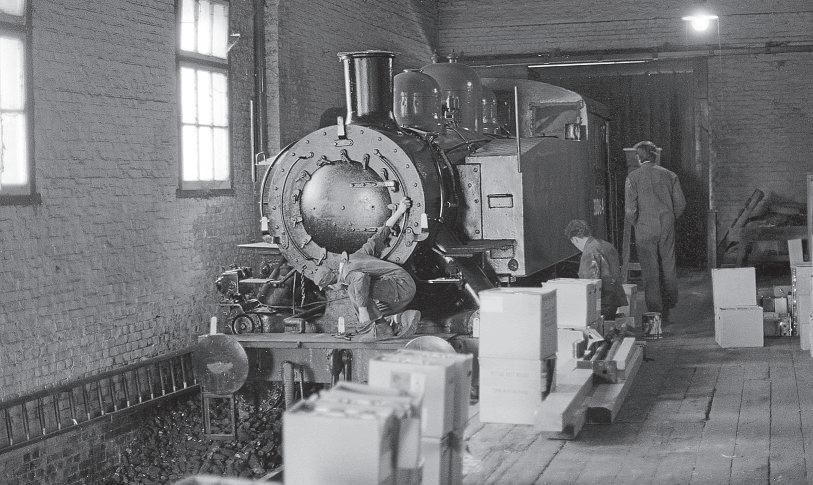
Th eN ovem be r1968S LP me mb er s’ tr ip so ut hea st fr om Dr ox fo rd ,a lo ng th eM eo nValley th ro ug hW ic kh am to ne ar th eE as tl eighFa re ha mlin eatK nowl eJ unct io na nd ba ck ,w as ab ou t13m il es allt ol d, th is view re co rd ingt he ret ur nwor ki ng ap pr oa ch ingD roxfor ds ta tion ; th elin eo nt he righti sal engt hy no rt h- fa ci ng si di ng.The fo rm at io ni sU SA No.300 64 ,t he BC Kfor co mfor t, an da Toad br akev an .N o lo nger ap as se nger ra il waya ft er Fe br ua ry 7, 1955 ,w he nt he se ct io nn or th of Dr ox fo rd to Fa rr ingd on wa sr em oved ,Far ri ng do n- Alto n an dK nowl eJ unct io n- Dr ox fo rd go od s- on ly br anch es we re cr eate datt hatt im e, bu tt he fr st wa sl os tf ro mAug us t5 ,1968, an dby Ap ri l1969t he so ut he rn se ct io np ic tu re dh er e wa sa ls os tate da sc lo si ng so on ,s ot ri ps fo r No.300 64 mu st have be en ve ry limite do nt hi s ro ut e. Jo hn
railwaysequences in itsdramaticmovie,Te YoungWinston,whichwentonrelease in 1972. It told theheroicstory of Churchill’searly life inthe Boer War, andNo. 30064, together with No.92203, played theparts of SouthAfrican locomotives. Avisit to ‘make-up’ sawthe loco fttedwitha cow-catcher andSAR emblazoned onits side tanks, butnot much else wasneeded duetothe loco’s already‘foreign’ appearance.Te 9F,however,neededrathermoretransformation, includinganenormousprostheticfbre-glass chimney,aswellasbeingrenumbered220. Sadly, No.30064 only hasaverysmall part in theflm, butthe movieiswellworth watching, notjust as an exciting recreation of Churchill’sswashbucklingdays, butbecause thereisextensive railwayactiontobeseen. Shortlyaferflmingwas completed,David Shepherd’s locos were hauled awaytoEastleigh and, afer itslastfing, theUSA alsodeparted, this time forthe Bluebell Railway.
‘banned’ Southern Region thirdrailterritory,and arrivedatLongmooronApril 6, 1968. Sadly,the grandioseschemenever reallygot of theground, butasimpler alternative, taking over part of the LMR at theLissend,was agreed andthe track wasleasedona short-termbasis in April1970.
On May30, 1970, Crompton Type 3Bo-Bo diesel No.6543appearedatFareham to marshal theSLP stockand haul it away to anew home On abeautifullysunnyday,the cavalcade set of viaHavantand thePortsmouth main line, making forthe exchange sidings at Liss.Tere seemed to be ahopethatthismight be the longed-for secure andpermanent base,but dueto highlyvocal opposition from thelocal ‘Nimbys,’ even this truncatedschemefailedtomove forward, so anothernew home wasneeded.
Fortuitously,s afehaven fort he SLPwas closeathand, within thegoods shed at Fa reha m, about 10 milessouth of Drox ford andatt he junction of theE astleigh routewit ht hatfromSouthampton anda long thecoa st ,soitwas fa rfromisolated. Technica lly, Fa reha myardwas stillopentopublic goodsatt histime, untilJune1,1970, andfor privatesidings long af tert hat, so this alloweduse wa s rema rkable .OnA pril 20,1969, we fndS LP volunteers work ingon No.300 64 during its‘hidden’life inside Fa reha mgoods shed.The loco is facing nort h, andt hisbuildingisont he ea st (Down) side of Fa reha mstation ,justa fewsteps across from themainstation building. John HB ird/RailwayImagesU K line. Fortunately, they managedtoget afoothold at nearby Farehamstation,withNo. 30064 hidden away in theold goodsshed, courtesy of afriendly stationmaster. Only abolthole, some restoration work wascontinued on thelocoatFareham,but a fourth career forNo. 30064 nowbeckoned. Te AssociationofRailway Preservation Societies (ARPS) hadbeenpromoting theidea of arailway andtransport museum complex at thenearbyLongmoorMilitaryRailway (LMR). Te huge Longmoor yard wasveryappealingfor apotential steamcentre, andwhencombined with the1½miles of trackconnectingittothe main lineatLiss, it wasapreservationist’s dream. At roughlythe same time,David Shepherd had returned home afer asuccessful exhibition in NewYorkwithenoughmoney to buytwo operational steamlocomotives, BR Standards Nos. 92203 and75029, andheidentifed Longmoor as an ideal base.Tey travelledthere in steamfromCrewe,includingtransit over the
Before that,however,No. 30064 hadabrief opportunity to be aflm star andtomakethe Churchill connection again. Columbia Pictures hired theLMR tracks forflming some of the
Areallyusefulengine,until putout to grass USA tank No.30064 arrivedatthe Bluebell at the endof1971, when thelinewas stillconfned to thesection betweenShefeld Park andHorsted Keynes. Te 0-6-0T sawalot of useright away andthroughoutthe 1970s, anditisremembered with afection by many Bluebell stalwartsfrom thosedays–there wasevena shortperiodwhen it wasthe only availablelocothatwas steamable! No.30064 wasinthe green-painted condition in whichitarrived untilsometimearound1983 when it fnally receivedaBRheraldic crestonits hitherto plaintanks sides.Itwas withdrawn from service shortly aferwardswithsomeserious defects. By this time,ownership of theSLP’s assets hadbeentransferred to theBluebell, so the future welfare of thelocodependedonthe Sussex line’spriorities. Te withdrawalprecededamost unhappyphase in thestory of No.30064.
Afer yearsout of use, 2003 sawthe USA tank ‘dressed up’asWDNo. 1959, itsoriginalidentity, in wartimegreyliveryfor a1940s weekend, and in that guise it laterattendedthe Warley National ModelRailway Exhibition at Birmingham’s NEC. On itsreturnsouth though,itsimplydid not seem to ft in with theBluebell’sfutureplans, possibly becauseitwas deemed to be heavyon thetrack, uncomfortablefor passengers with its‘wiggly’motion, andbecause thepotential repairstobring it back to operating condition were expensive.Above all, arguably theBluebell

Incredibly,at hird preser vation home beckonsfor No.300 64 ,a nd it is only May30, 1970.Birmingha mR ailway Ca rriage &Wagon Co Bo -BoSulzer Type 3No. 6543 (later Class33No. 33025) is at theheadofS LP stockont he throughlineatH avant, waitingfor apat hUpt he Portsmouth Direct line;t he junction is in thedista nce, therequiredroute diverginglef t. A4 -VEP electric-multiple- unit ,No. 7703,ispulling away butt here seemstobea rela xedvibefor thosewit ht he tr ain, so thewaitlooks to be ongoing. ThemoveisfromFareham to Liss ,a bout 23½miles ,but theneedfor No.300 64 to tr avel withoutits coupling rods ma kesfor aslowjourney andt he need foralengt hy ga pbet ween ot hert rains. In addition to theU SA ta nk ,t he pay load is Maunsell BC KNo. S6686S ,ventilatedpassenger luggagevan No.DS1686(5498)a nd theS LP ’s Toad. John HB ird/RailwayImagesU K

Railwayhad toomuchstock to restoreand not enough moneyormanpowertodoso.
Te fate of thelocofor thenext40years caused many to complain aboutwhatappearedto be totalneglect.Dumpedonceagain in theopen air(like in the1940s), it deterioratedrapidly; no doubt, itscondition explained itsreasonably inconspicuouslocationatHorsted Keynes.
In 2022, theBluebellRailway Preservation Society(BRPS) announcedthatthisunhappy chapterwas comingtoanend,as aprice for thesaleofNo. 30064 hadbeenagreed. Paul Churchman, chairman of theBRPS, said that a disposal list of vehicles hadbeenmadeand that No.30064 required about£40,000 to be spent just to remove theasbestosinthe locomotive
Furthermore, therewas currentlynoplaninthe next 20 yearstohavethe loco restored,hence the sale.Terehad been much angeramong some Bluebell supporters at theway theYanktankhad been lef unprotectedinopenstorage,sothe news was welcomedbymany, albeit with sadnessasit hadbeenanimportant mainstay of operationsat onetime. Te one-timeSLP’s Southern Railway Maunsell composite brakecarriage, No.6686, was notsold, however, andcontinues in operation in itssuperb1930s Southern Railwaylivery.
ABritsaves the USA
OnJune22, 2022, No.30064 lefthe Bluebell, headingofto athensecretnew home at asecure private base at Southall.Its newowner,well-known
Pr es er vation ho me nu mb er fo ur wa sr at he r mo re fr uitf ul fo rN o. 30 064for ma ny ye ar s, th eB lu eb ellR ai lw ay in Su ss ex .Thi sc irca 19 80 scen er ecor ds th eU SA 0- 6- 0T pi loti ng Bu ll ei d Q1 0- 6- 0N o. 33001, pa rt of th eN at io na l Co ll ec tion ,t he pa ir pr ov id ingas tr ongS econ d Wo rl dWar am bience as th ey do ub le -h ea d aH or st ed Keyn es -b ou nd tr ai n. Th eVulca n circ ul ar wo rk sp late pa rt ia ll yv is ib le be hi nd th e wh it ed is cw as or ig in ally ca rr ie do nt he fr ontof th el ocof ra me bu tw as move dt ot hi sp os it io n on th eh inge db uf fe rb ea mp late du ri ng it s time at th eB lu eb ell. Paul Ke ar ley
in SR preservation circles, hastaken on amassive task,but hashighhopes of asuccessful outcome. Te loco even hasits ownFacebook page –30064 USA Tank –where occasionalupdates appear At thebeginningof2023, it wasrevealed that allthe asbestos hadbeenremoved by certifedcontractors andthat, thankfully, it appeared that theboilerhad sufered minimal wastewhile thelocowas dumped Subsequently, theboilerwas needle-gunned readyfor thicknesstesting.Terewas also a photograph showing that No.30064’soriginal frontnumberplate hadbeenreunitedwithits smokebox door whilethe latter wasremoved from theenginefor thefttingofnew hinges. By thesummer of 2024, it wasreportedthatthe scaleofthe work needed wasveryobvious,with ‘the cabcurrently beingrebuilt from theground up,withthe existingstructure beingusedas atemplate. Te twocab foor supportirons whichstretch acrossthe full widthofthe cab, despite beingofhalf-inchthickmaterial, have more or lesscompletelyrottedaway; therear onesuferingthe worstdue to theefectsofcoal dust.Likewise, thehandbrake supportbracket, whichisweldedtothe frames,was so badly wasted that reverseengineering wasnot possible

andthe original drawing hadtobesourced to manufacture anew one; again, this washalfinch steelwastedawaytonothing.’
Next tasksweresaidtoinclude ftting anew steelfoorand replacingand repairingfurther sections of thecab structureand itssupports. More recently, work has focussed on getting theboilerde-tubed,alongside thecontinued rebuildofthe caband bunker, andthe servicing andoverhaulofvarious fttings.Inthe owner’s words, “itisall lookingpositive,and coming alongnicely!”
Tere is no public accesspossibleat presentand it will clearlybeafew yearsbefore No.30064 returnstoaction, when it will befnishedinBritish Railways blackliver y, completewiththe latter versioncrest.Maybe No. 30072 will also be back in servicebythen, and with ex-No. 30065 nearingthe endof its restorationatthe Kent &EastSussexRailway therecould be atrioofUSAsinaction. If
we addin theYugoslav-manufacturedUSA lookalike,No. 30075,which wasbeingteststeamedatShillingstone at thetimeofwriting, thismakes aquartet. Tatcould make for aninteresting gala attraction at apreserved railwayone day. With twoother USAscurrently sidelined, needingmajor rebuilding, therecould even be half adozen of thesetankengines to see inthe UK in thefuture. Looking furtherafeld, if we includeforeign-basedsur vivors such as splendid Davenport-built example USATC No.4389, locatedatStoomtrein Goes-Borsele in theNetherlands,the survival rate of theS100s is impressive –not badfor adesignthatwas built 80years agofor aspecifcshort-termpurpose andinemergencycircumstances, andin factories 3000 miles distantfromthese shores.
Grateful thanks to JamesBunch (currentowner of No.30064), Roger Hardingham,MikeLamport (exSLPowner), RonNeal, Paul Kearley, CharlieVerrall,

Although withdrawnfromBluebellser vice in themid-1980s,2003saw No.30064 returned to itsformerguise as WD No.1959for a1940s weekend. Whileitwas good to seethe now former SLPlocoenjoyingthe limelightfor a while, this view recordsthe S100 on April11, 20 04,while parked outsideatSheffeldParkand againout of thenews. Although centre stage displayatthe NECin2010was ahead, it seems that therewas little chance that therequired fundstooverhaul/repair thelocowerecoming anditdeterioratedintoasorry state, aworld away from themalachite green-liveried favourite of the1960s. Trevor Davis/ Transport Treasury
DavidWardand Robert Wigley (ex-SLP), andin particular to Doug McQuirter, archivistofthe Hagley Museum andLibrary in Delaware,USA, for making availableVulcanWorks materialsfromits collection Also,EdLovefor revealinghis family connection, andJohnWRendleand Matt Mocs, of theVulcan IronworksLocomotiveAppreciationSociety
Locomotives of theSouthernRailway Part 1–DLBradbury –RCTS(1975)
Bulleid of theSouthern–H AV Bulleid –Ian Allan(1977)
Bluebell SteaminRetrospect– MichaelWelch –BRPS (1980)
Southampton’sRailways–BertMoody –Waterfront (1992)
AlliedMilitaryLocomotives of theSecondWorld War–RTourret –Tourret Publishing(1995)
Te Storyofthe Southern USA Tanks–HSprenger, KRobertson andC Sprenger –KRB Publications (2004)
Southern RailsonSouthampton Docks–IanDrummond–Holne Publishing(2013)
Te Ramblings of aRailwayman– Geof Burch (secondedition,2016)
Te MonthlyBulletinofthe Locomotive Club of GreatBritain;the SLSJournal;TeRailway Magazine;TeRailway Observer Websites: www.sixbellsjunction.co.uk; www. portsmouth.co.uk/news/people/droxford-thelittle-village-that-loomed-large-in-the-d-day-story



Inspired by his role within aNor th Wales coast main line traffc sur vey undertaken on the busiest day forholiday traffc in 1954, Chris Forrest deliver shis data from that day,inc luding some exGWR duties ,and offer sthe ongoing picturethrough to August 1963 with fur therobser vations of high-season long-distance passenger work in and around Chester.
Inthe summer of 1954 Iagreed to spend aSaturdayatChester stationrecording thetrafc on theNorth Walescoast main lineaspartofa survey beingcarried outbythe Manchester LocomotiveSociety Tismadeuse of 25 observersstationed at strategicpoints, both alongthe coastand at places inland,nearertothe points of origin andthe return destinationsof thetrains–the detailedprogressoftrainsfromasfar afeld as Newcastle-upon-Tynewas thus followed andafascinatingdocumentproduced. So,on Saturday,July31, 1954,havingjustreturned from twoweeks of observationatCarlisle, I arrivedatChester (General)station at 10am, prepared forthe busiestSaturdayofthe year. In theaccompanying tables Ihavedetailed my ownobser vationsand used thereportof thesur veytoadd anumberofrelevantdetails TableOne covers Down trains on theNorth Wales coastduties andinall Irecorded59of these; andthere were 68 in theUpdirection
On th ef aceofit, ta ki ng on th et as kofr ecor di ng allN or th Wa le scoa st ma in li ne tr af fc th ro ug h Ch es te rs tation mights ee mr el at ivel ye as y, th ough qu it ee xh au st inga cr os sn in eh ou rs on th e bu sies tofs um me rS at urd ays, bu ta lo ng with th ep it fa ll sofn ot kn ow ingi fs om et hi ng maya pp ea r at anym om enta st im ekee pi ng wa ss op oo r, wa st he pr ob le mofocc as io na ll yn ee di ng to be aw ay fr om th eb es tp la ce to se eeve ry th ing. Th is ea rl y195 0s scen ei ll us tr at es on eoft he ea sier th ings to mi ss ,aL la nd ud no -L on do ne xp re ss ente ri ng th es tation on it sn or th /e as tf an k, wh il el ongdi st ance su mm er Satu rd ay ex tr as notb oo ke dt os to pm ig ht simp ly pa ss on at hr ough li ne .The loco is na me le ss Fowl er Patr iot4 -6 -0 No.4 5510 :t he sh ed co de is notl eg ib le bu titw as at Cr ewe No rt hf ro mM ay 28 ,1949, th ro ug ht oJ anua ry 29,1955, with th ee xcep tion of twos ho rt br ea ks –si xwee ks at Edge Hi ll in ea rl y1951a nd 11 we ek satW ille sd en in su mm er 1952 –w hich le aves th e ot he r279 we ek sa sa5Aa ss et Ji mFli nt &J im Harb ar t/ Tr an sp or tTre asur y
With up to 25 trains perhouratpeakperiods on thecoastal main linealone,recording details of loco,stock,platform, andarrival and departure timeswas noteasyand leflittletime for‘personal needs.’Terefore, at thebusiest times, Ihaveonlyshown thetimes in hourly groups rather than risk reproducingperhaps slightly inaccurate estimates. No attemptwas made to record in detail thetrafc on the Birkenhead or WesternRegionlines, or the localser vicesbetween Chesterand Crewe, Whitchurch,ManchesterorLiverpool. Ihave used theallocated reportingnumbers,which ofen was notthe oneIrecorded, since the number displayedwas notalwayscorrect.For example,the 4.15pmLiverpool-AfonWen (W417)appearedasW147A. Apartfromthe dyslexic digits, the‘A’ sufx wasincorrect as it appliedtoLlandudnotrains, with ‘B’usedfor Bangor andbeyond. Most trains did usethe ‘A’and ‘B’notation, with even theDownIrish Mail showing‘W37B.’
It is worthnotingthatfor the59Down trains therewereatleast 22 starting points, andthat40ofthese duties were headingto Llandudno’sterminus,withsix to Holyhead, butthere were four intermediate terminating points too–Rhyl(threetrains), Abergele (1), LlandudnoJunction(1), Bangor (4) –while
southofBangorthere were four long-distance trains throughCaernarvon to theCambrian coastatAfonWen (1), includingone each west andeastfromthere,respectivelytoPenychain forits Butlin’s holidaycampand to Portmadoc. From atrainspotter’sperspective,there wasa broadspreadofallocations,withmynotes for theoutward trains aloneincludinglocos from 24 diferentsheds,asfollows: 1B Camden, 2A Rugby, 3D Aston, 5A CreweNorth,5B CreweSouth,6A Chester, 6B Mold Junction, 6C Birkenhead,6GLlandudnoJunction, 6H Bangor,6JHolyhead, 6K Rhyl,8AEdge Hill,8BWarrington(Dallam), 9A Longsight, 9B Stockport(Edgeley),10B Preston, 10C Patricrof,12A Carlisle (Upperby), 17B Burton, 19A Shefeld(Grimethorpe), 25G Farnley Junction,26A Newton Heathand 26B Agecrof.
On summer Saturdays, trafclevelsreached saturation pointfor afew hourseachday,but at Chesterthe only real operating problems inthe immediate stationareawerecausedby conficting movementsatthe junction of the Manchester andCrewe lines to theeastofthe station, andatthe otherend when Western Region trains were crossingtoand from the Birkenhead line. Of note is that some usewas made of thethrough lines, whichallowed nonstop trains to overtake thoseinthe platforms.
Down NorthWales coasttrains leavingChester :July31, 1954
Time TrainRep.No. Loco Shed Mins late Notes
10am8.35 Manchester-BangorW453 44680 5A 21
8.45 Manchester-LlandudnoW455 45129 10C 2Non-corridor
7.15 Stechford-LlandudnoW327 45058 3D 5Extra
8.36 Stoke-LlandudnoW815 42724 26B 41 Extra; non-corridor
8.50 Etruria-LlandudnoW816 42977 6C 31 Extra
9.25 Manchester-LlandudnoJunctionW369 45599 12A 8
10.00 Birkenhead-LlandudnoW403 42451 6A 1
6.30 Leamington-LlandudnoW333 45349 3D 22
6.42 Rugby-LlandudnoW345 45403 2A 21 NBRnon-corridor
9.20 Liverpool-LlandudnoW403 45039 8A 15
9.20 Stoke-PenychainW355 45060 5B 7
9.45 Manchester-LlandudnoW401 45147 10C 8early 8.45 Birmingham-LlandudnoW329 44713 2A 10 11am9.35 Liverpool-Penychain W399 45032 8B 11
8.35 Smethwick-LlandudnoW339 45332 10B 10 Non-corridor
8.50 Derby-LlandudnoW101 42846 17B 11 11.00 Chester-Rhyl 46422 6K 20 10.00 Manchester-HolyheadW421 44868 6J 7 10.35 Liverpool-LlandudnoW405 45242 8A 15 8.04 Leicester-LlandudnoM46 45446 5A 6 10.20 Manchester-LlandudnoW375 45057 10C 14 Club Trainstock
9.50 Ford Green-LlandudnoW811 42878 26A 6Extra; non-corridor
8.45 LeedsCity-LlandudnoC444 45080 25G 16 11.00 Crewe-LlandudnoW87 46119 1B 22
noon 10.25 Manchester-BangorW457 42813 5B 32 8.05 London Euston-HolyheadW49 45586 5A 5 9.15 DerbyMidland-LlandudnoW135 42772 9A
11.00 Manchester-LlandudnoW319 44065 6B 6 8.15 London Euston-HolyheadW37 46106 5A 23 Te IrishMail 9.12 LeedsCity-LlandudnoC448 45275 6B 3 10.10 Shefeld-LlandudnoM26 44855 19A 2early 9.37 LeedsCity-LlandudnoC900 45352 10C 18 early Extra 12.45 Chester-Rhyl 41287 6K 6 9.20 Bradford-LlandudnoC901 45180 6J 34
11.25 Manchester-LlandudnoW459 45445 12A 2 1pm9.50 Bradford-LlandudnoC446 44684 5A 33 9.20 London Euston-HolyheadW51 46139 1B 5 10.40 Shefeld-LlandudnoM28 44802 19A 5early 12.30 Warrington-LlandudnoW513 45307 5A 6Extra; non-corridor 11.55 Manchester-HolyheadW461 45071 5A 11 45043 (6A) pilottoChester Shefeld Midland-LlandudnoM948 42934 9B 3Extra 2pm12.45 Liverpool-LlandudnoW221 41119 6G 3 2.10 Chester-Abergele W648 41153 6A 20 Relief
1.58 Crewe-LlandudnoW249 44770 5A 10 1.30 Liverpool-BangorW415 73041 6A 1 1.30 Manchester-LlandudnoW393 44913 6H 6
3.12pm1.35 Manchester-LlandudnoW471 73042
3.29pm11.15 London Euston-PortmadocW89 46126
3.40pm11.22 London Euston-LlandudnoW181 45591
20 45528 (1B) to Chester
3.45pm2.45 Crewe-LlandudnoW119 45093 6J 15 Non-corridor
4.30pm3.15 Manchester-LlandudnoW479 45444 10C 5
5.26pm4.25 Crewe-BangorW111 45048 5B 25
5.32pm 4.15 Liverpool-AfonWen W417 45290 10C 10
5.29pm5.20 Chester-Rhyl 42093
5.40pm11.35 Newcastle-LlandudnoC490 42975 6B 63
6.03pm5.12 Crewe-LlandudnoW125 44738 6G 13
6.21pm5.05 Liverpool-Holyhead W419 44740 6G 1
6.29pm4.30 Manchester-LlandudnoW483 42982 6B 44
Once clearofthe stationand headinginto Wales, majoroperating difculties began. Ideally, four-tracks were needed forthe whole 44¼-mile lengthoflinefromChester to LlandudnoJunctionbut therewas afvemile bottleneckoftwo-tracksonlybetween Connah’s Quay andMuspratt’sSidings,just west of Flint, andtoa lesserextentanother 3½mile two-tracksection from Llandulasviaduct to Colwyn Baystation also caused problems
Although therestofthe routehad four-tracks, with platformsonlyonthe slow lines at the smaller stations,the insertionofthe occasional all-stationstrain caused furtherdelays. London MidlandRegionfreight waskeptwellclear of themainlineonthese busy days, butthe WesternRegionsentits goodstrafc intothe congestionregardless. Te inevitable delays couldbemadeworse by mechanical problems andunscheduled waterstops.
Forthe Down trains recorded,anaverage lateness of 12 minutes on leavingChester was convertedto44minutes on arrivalattheir destination or at thenearest pointincludedin thesurvey. Tatis, each trainonaverage lost abouthalfanhouronthe 44¼-mile journey from ChestertoLlandudnoJunction. At the busiestperiod, most trains arriving in Llandudno were an hour or more behindtime–managing thestation theremusthavebeenanabsolute
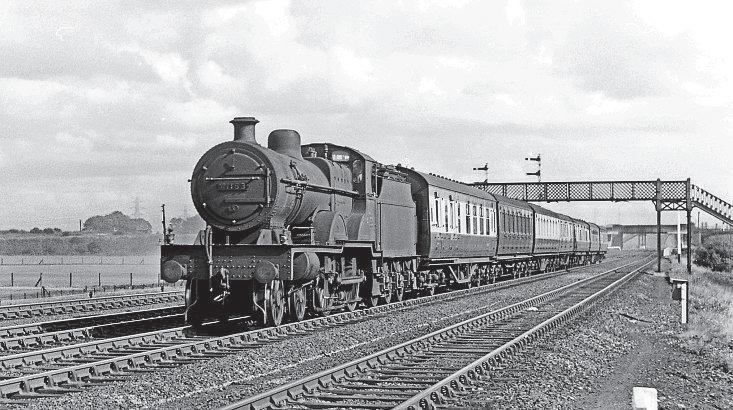
In 1954,LMS Compound 4P No.41153 approaches Shot ton(LowLevel)onthe fourtracksection of line from Chesterwiththe 1. 35pm Manchester-Holyheadser vice.The railwayjustpassedbeneath is theex- Great Central/LNER Wrexham- Seacombe route, fedbyalinktoChester Northgatefor CLC connections. AllocatedtoChester ’s LMRshed (6A),onthe Saturday of theauthor’slog this 4- 4- 0headedthe 2.10pm Chester- Abergele service; relief duty W648.Inthe height of summer,almostevery NorthWales coast main line traincarried itsrepor ting number on aSaturday, theexception tendingtobelocal stopping trains,sothisviewismostlikelybefore thehighseasontimetable or notonaSaturday Oneofthe Fowler eraCompounds,the pictured engine served from September1925and until theweekendingNovember2 ,1957, itsfnalshed beingBournville. SD Wainwright /RailPhotoprints

nightmare.Fortunately,thissortof thing happened on only afew Saturdayseachyear. Idid nothaveenoughdatato do asimilar analysisfor trains in theopposite direction,and anyfgures wouldbedistorted by thelatearrival of theIrish ferry. WhileTable Twolists my own observations forUptrains, it is apparent that
most of thepoorpunctuality of thesewas more ofen than notcausedbystock notarrivingin time from theopposite direction Iarrived at Chestertoo late to seethe passage of what wasgenerallyacknowledgedtobethe day’s highlight,train E166 from Nottingham (Victoria) to Llandudno, whichwas scheduledtoproduce the
only EasternRegionlocoofthe day; Tompson B1 class4-6-0No. 61141 from LeicesterGC (38C) engine shed wasincharge on theday and was reported to be in very poor condition, losing time steadily andfnallyexpiringonreaching Llandudno. It wasreplacedonthe return working by Stanier ‘Black Five’class 4-6-0 No.45302 (10C,
ic hs ho ul dh avec alle dj us t12m inut es in it sw ake. It is notk nown wh at time it re ac he dR hy lb ut re co up inga ny of it sl os t63m inut es on th ecoa st al se ct io no ns uc hab us yd ay se em su nlikel y. Th e engi ne is St an ie r2 -6 -0 No.42975 of Mo ld Ju nc tion ,its ho me si nceN ovem be r1941. Fr om ea rl yB Rd ayst om id -196 0t he cl as sw as rate da s6P/ 5F,o n pa pe ratl ea st ,w hich wa sa rg ua bl ya bove th eirc ap ab ilit y– th is 11-coa ch du ty is pu sh ingt he enve lo pe .N ot et he mi xe db ag of st oc k, ty pica lofs uc h days wh en ever yt hi ng po ss ib le wa sd ragged into us e. Th eS ta nier 2- 6- 0s we re bl es se dw it hm anyn ic kn am es ,w hich ha dm os tl yevo lved fr om th e ‘C ra bs ’t hatt heyfollowe d; to so me th is is a‘ Lo bs te r’ at th es ea si de BG re en /K id de rm in st er Rail wayM useu m/ Kidd er mi ns te rR ailw ay Mu se um
